English
Title: Injection of Inner Oort Cloud Objects Into the Distant Kuiper Belt by Planet Nine
Authors: Konstantin Batygin and Michael E. Brown
First Author’s Institution: Division of Geological and Planetary Sciences, California Institute of Technology
Paper Status: Accepted to The Astrophysical Journal Letters [closed access]
Ladies and gentlemen, welcome aboard the Astrobites Airlines with service from the Earth to Planet 9. We are currently fourth in line for take-off, but you can learn more about other take-offs to Planet 9 here, here, and here. We are traveling at the speed of light and the duration of our flight will be about 70 hours. We ask you that you please enjoy our long journey to the outer Solar System.
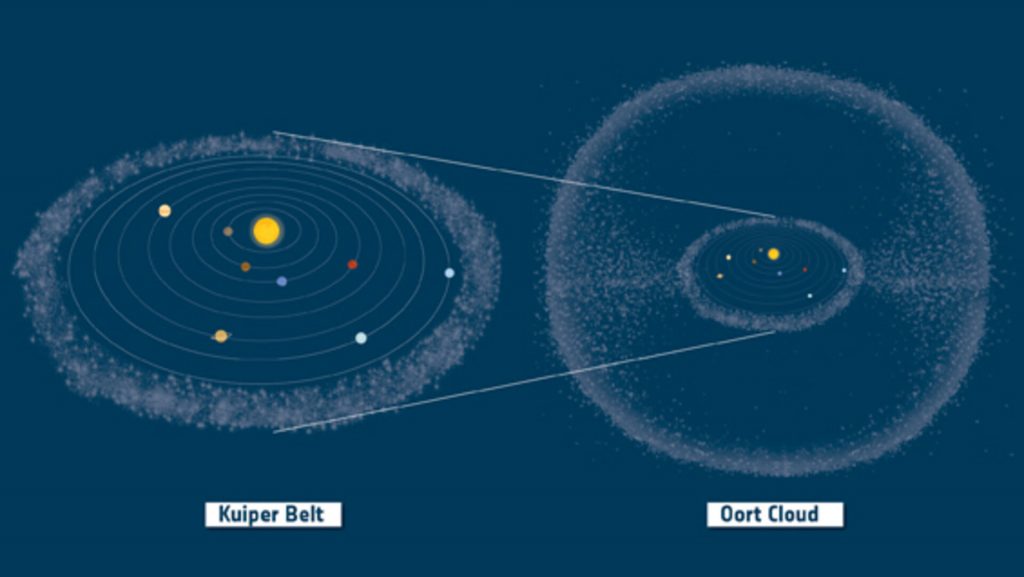
Our journey starts in the Kuiper Belt, a ring of icy bodies residing beyond Neptune’s orbit. Look around, these are distant Kuiper Belt Objects (KBOs) (look at Figure 1)! We can see (also in Figure 2) two distinct types of distant KBOs: some KBOs have dynamically stable orbits and some do not. Those that are unstable are destabilized by Neptune. The observed clustering of stable orbits needs to be affected by something so that it maintains orbital alignment against differential precession induced by Jupiter, Saturn, Uranus, and Neptune (huge planets that have a huge gravity!). So, what is affecting the orbits of the stable KBOs? The authors of today’s paper think it could be Planet 9!
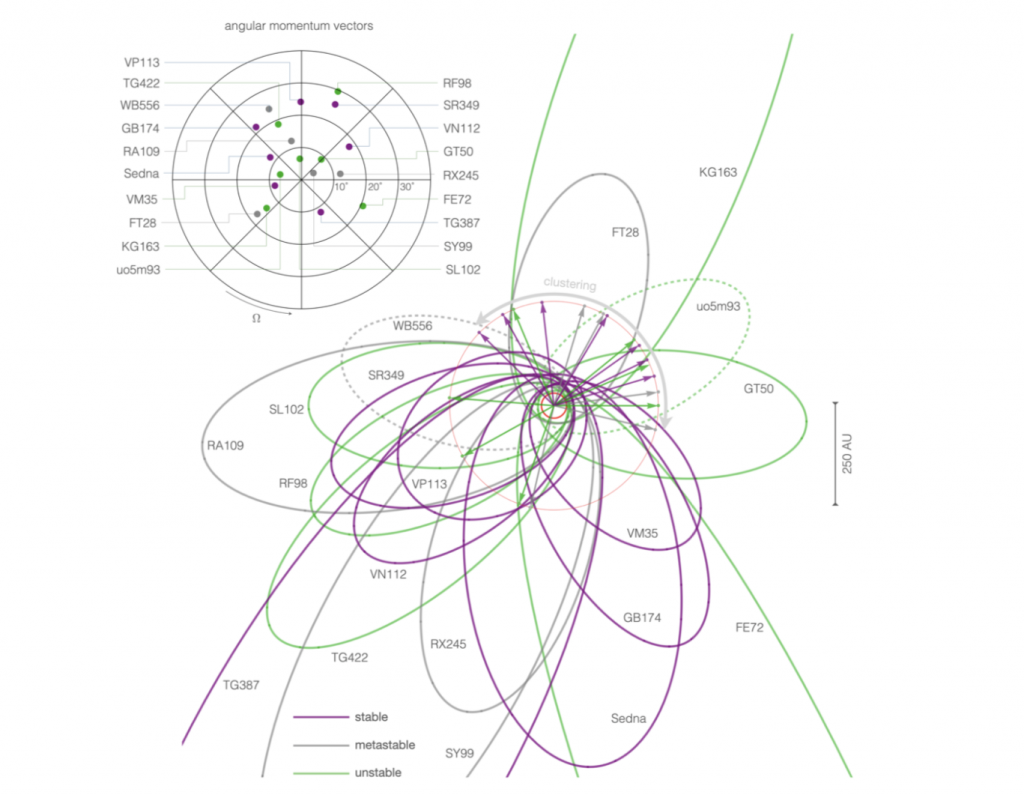
We forgot that the Universe is BIG!
The authors have been working on Planet 9 for a long time (their first paper was published in 2016)! During this time, they made some estimates on dynamical properties of the planet we are heading to right now. For example, Planet 9 might have a mass of 5 Earth masses, with a semi-major axis of 500 AU, an eccentricity of 0.25, and an inclination of 20 degrees from the data that was observed (Planet 9 itself has not yet been observed). However, all this time, the authors treated the Solar System as an isolated object, neglecting all objects that attain a heliocentric distance of over 10,000 AU. But they are still there! Their assumption is valid for representing the evolution of objects with semi-major axes on the order of a few hundred AU. More recent detections of trans-Neptunian objects (TNOs), however, increasingly point to a pronounced abundance of long-period TNOs with a heliocentric distance of over 10,000 AU. This orbital domain borders the inner Oort cloud (IOC). For scaling reference look at Figure 1. More importantly, the population of debris in the IOC is stable, just like the KBOs mentioned above! So, the authors’ hypothesis is that some of these stable KBOs were injected into the Kuiper Belt from the outside by being affected by the Galaxy and by Planet 9.
The tug of war between giant planets and stars
As we go further and further from the Sun on our spaceship, it is important to note that the Sun’s birth environment played an important role in shaping the Solar System. After all, the Sun is the reason we have the Solar System in the first place! The Sun, like any other star, was born in a big family of stars – a cluster. Now, it’s time to wear your glasses, because it’s simulation time!
The authors made an N-body simulation of the formation of the Solar System including Jupiter and Saturn (they are significant because they are huge) and 100,000 planetesimals, spanning the 4.5−12 AU range in the heliocentric distance in initial circular and coplanar orbits. They modeled the Sun’s birth cluster as a Plummer sphere. The Plummer sphere is often used in N-body simulations to “soften” gravity at small distance scales. This is needed to prevent the point particles from scattering too strongly off of one another on a close approach. Along with Jupiter and Saturn, they also modeled “passing stars” – members of the Sun’s family that might have affected the debris gravitationally. All of it, the concurrent growth of giant planets and the passing stars, affects the planetesimals. Think of it as a tug of war between Jupiter and Saturn on one side and the passing stars on the other side. Because these icy objects (aka planetesimals) don’t know where to go, they choose to “freeze” in place, thousands AU away from the Sun. These are what the IOC is formed of.
Have we reached Planet 9 yet?
Dear passengers, it’s the time for another simulation! In absence of Planet Nine, the IOC created by the tug of war between giant planet scattering and the passing stars would essentially remain dynamically frozen over the main-sequence lifetime of the Sun. But that’s because Planet 9 wasn’t considered in the first simulation. Let’s see what happens when the authors add Planet 9.
In this simulation, the authors accounted for the dynamics driven by Neptune, Planet 9, and the passing stars as well as the effect of the Galactic gravitational tidal field and the average effect of Jupiter, Saturn, and Uranus. They found that over the lifetime of the Sun, a significant fraction (that is, on the order of 20%) of the IOC gets injected into the distant Kuiper belt. The authors also found that these re-injected IOC objects exhibit orbital clustering, which is important for the Planet 9 hypothesis (see the previous bite for more detail)! However, the degree of clustering is considerably weaker. The data suggests that Planet 9 might be even more eccentric than we thought. So, our journey might take a little longer! Another key result of the simulation is that IOC objects display a very extended semi-major axis distribution, which might explain objects like the Goblin!
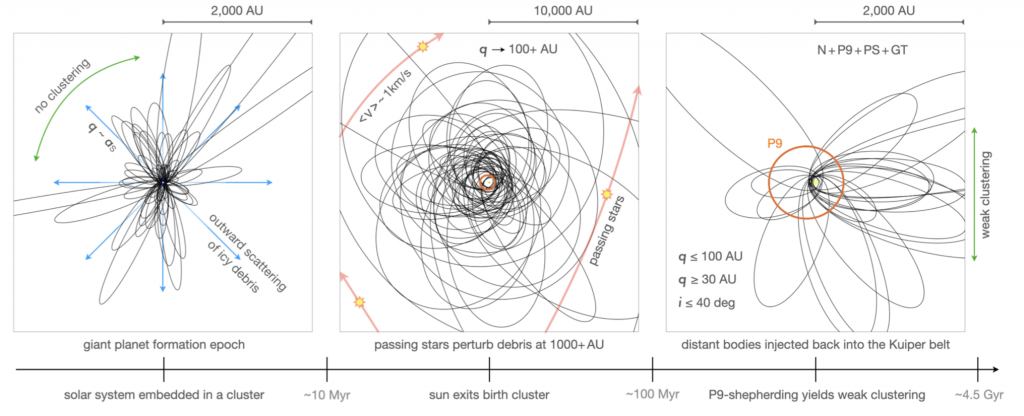
We are happy that you chose us again for your journey! We are really excited to see what is really out there, far away in the Solar System. Thank you for choosing Astrobites Airlines!
Astrobite edited by: Catherine Manea
Featured image credit: templatelab.com
Russian
Название: Введение объектов внутреннего облака Оорта в далёкий пояс Койпера Планетой 9
Авторы: Константин Батыгин и Майкл Браун
Учреждение первого автора: Отделение Геологических и Планетарных Наук, Калифорнийский Технологический Институт
Статус статьи: принята в The Astrophysical Journal Letters [закрытый доступ]
Дамы и господа, добро пожаловать на борт Astrobites Airlines, выполняющий рейс с Земли на Планету 9. В настоящее время мы четвёртые в очереди на взлёт, но вы можете узнать больше о других взлётах на Планету 9 здесь, здесь и здесь. Мы летим со скоростью света, а продолжительность полёта составит около 70 часов. Мы просим вас насладиться нашим долгим путешествием во внешние области Солнечной системы.
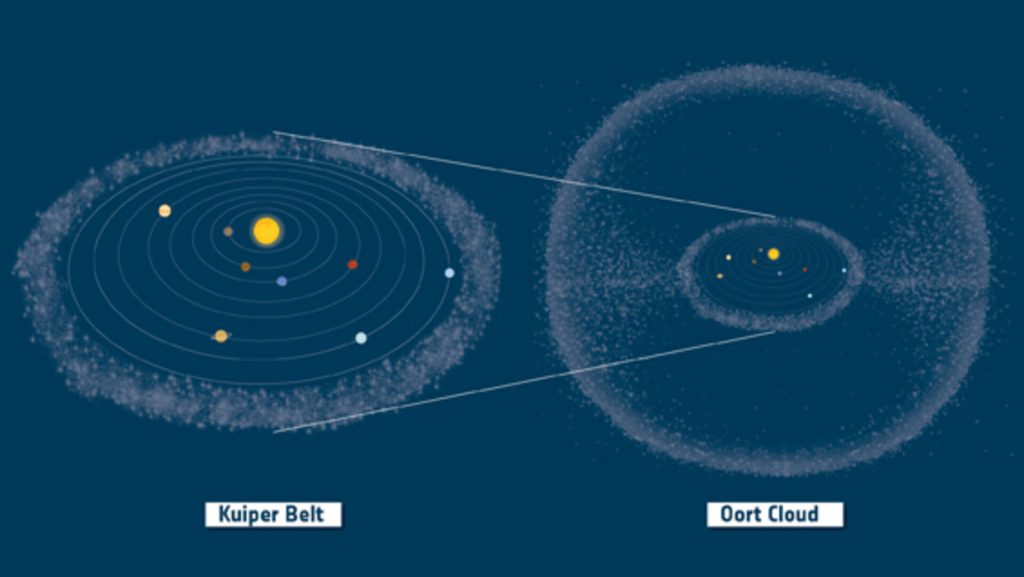
Наше путешествие начинается в поясе Койпера, кольце ледяных тел, находящихся за орбитой Нептуна. Посмотрите вокруг, это далёкие объекты пояса Койпера (ОПК) (рисунок 1)! Мы можем видеть (также на рисунке 2) два различных типа удалённых ОПК: некоторые ОПК имеют динамически стабильные орбиты, а некоторые – нет. Те, что нестабильны, дестабилизируются Нептуном. На наблюдаемое скопление стабильных орбит должно что-то влиять, чтобы поддерживать выравнивание орбит против дифференциальной прецессии, вызванной Юпитером, Сатурном, Ураном и Нептуном (это огромные планеты с огромной гравитацией!). Итак, что влияет на орбиты стабильных ОПК? Авторы сегодняшней статьи думают, что это могла быть Планета 9!
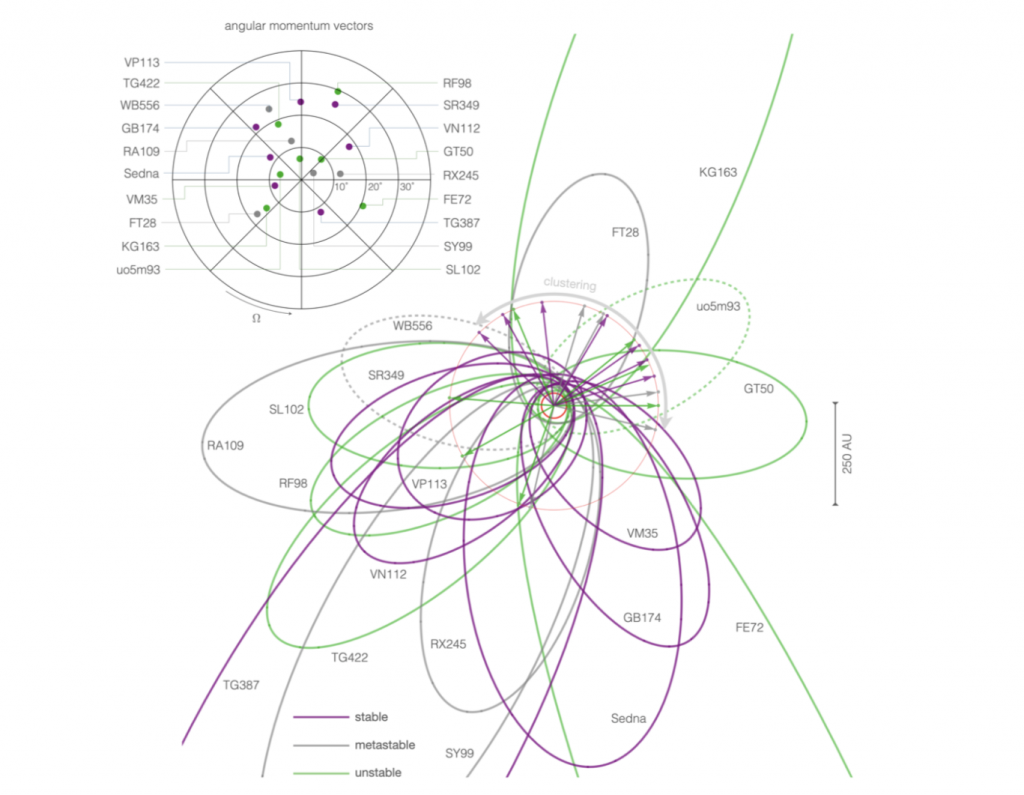
Мы забыли, что Вселенная ОГРОМНА
Авторы давно работают над гипотезой о Планете 9 (их первая статья была опубликована в 2016 году)! За это время они сделали некоторые оценки динамических свойств планеты, на которую мы сейчас направляемся. Например, Планета 9 может иметь массу равную 5-ти массам Земли, с большой полуосью в 500 а.е., эксцентриситетом 0,25 и наклоном в 20 градусов, имея кое-какие данные наблюдений (сама Планета 9 ещё не была наблюдена). Однако, всё это время авторы рассматривали Солнечную систему как изолированный объект, пренебрегая всеми объектами, которые достигают гелиоцентрического расстояния более 10 000 а.е. Но они ведь всё ещё есть! Их предположение действительно для представления эволюции объектов с большой полуосью порядка нескольких сотен а.е. Однако недавние обнаружения транснептуновых объектов (ТО) всё чаще указывают на явное изобилие долгопериодических ТО с гелиоцентрическим расстоянием более 10 000 а.е. Эта орбитальная область граничит с внутренним облаком Оорта (ВОО). Для справки по масштабированию см. Рисунок 1. Что ещё более важно, объекты в ВОО стабильны, как и в упомянутых выше ОПК! Итак, гипотеза авторов состоит в том, что некоторые из этих стабильных ОПК были введены в пояс Койпера извне, будучи гравитационно затронутыми Галактикой и Планетой 9.
Перетягивание каната между планетами-гигантами и звёздами
По мере того как мы удаляемся от Солнца на нашем космическом корабле, важно отметить, что среда рождения Солнца сыграла важную роль в формировании Солнечной системы. В конце концов, Солнце – это в первую очередь причина того, что у нас есть Солнечная система! Солнце, как и любая другая звезда, родилось в большой семье звёзд – скоплении звёзд. А теперь пора надеть очки, потому что пришло время симуляций!
Авторы провели симуляцию образования Солнечной системы, включая Юпитер и Сатурн (они значительны, потому что они огромны) и 100 000 планетезималей, охватывающих диапазон с 4,5–12 а.е. по гелиоцентрическому расстоянию на начальных круговых и компланарных орбитах. Они смоделировали скопление рождения Солнца как сферу Пламмера. Сфера Пламмера часто используется в таких симуляциях, чтобы «смягчить» гравитацию на малых расстояниях. Это необходимо для предотвращения слишком сильного рассеяния точечных частиц друг от друга при близком сближении. Наряду с Юпитером и Сатурном они также смоделировали «проходящие звезды» – членов семьи Солнца, которые могли гравитационно воздействовать на объекты. Всё это – одновременный рост планет-гигантов и проходящих мимо звезд – влияет на планетезимали. Думайте об этом как о перетягивании каната между Юпитером и Сатурном с одной стороны и проходящими звездами с другой стороны. Поскольку эти ледяные объекты (также известные как планетезимали) не знают, куда идти, они предпочитают «замёрзнуть» на месте, в тысячах а.е. от Солнца. Это то, из чего состоит ВОО.
Мы уже достигли Планеты 9?
Уважаемые пассажиры, пора посмотреть на ещё одну симуляцию! В отсутствии Планеты 9 ВОО, созданное перетягиванием каната между рассеянием гигантских планет и проходящими мимо звёздами, по существу, оставалось бы динамически заморожённым в течение всей жизни Солнца на главной последовательности. Но это потому, что Планета 9 не рассматривалась в первой симуляции. Посмотрим, что произойдет, когда авторы добавят Планету 9.
В этой модели авторы учли динамику, управляемую Нептуном, Планетой 9 и проходящими звёздами, а также эффект галактического гравитационного приливного поля и средневыраженный эффект Юпитера, Сатурна и Урана. Они обнаружили, что за время жизни Солнца значительная часть (то есть порядка 20%) ВОО попадает в далёкий пояс Койпера. Авторы также обнаружили, что эти повторно введённые объекты ВОО демонстрируют орбитальную кластеризацию, что важно для гипотезы Планеты 9 (подробнее см. Предыдущий байт)! Однако степень кластеризации значительно слабее. Данные показывают, что Планета 9 может быть даже иметь более большой эксцентриситет, чем мы думали. Итак, наше путешествие может занять немного больше времени! Другим ключевым результатом моделирования является то, что объекты ВОО отображают очень расширенное распределение по большой полуоси, что может объяснять такие объекты, как Гоблин!
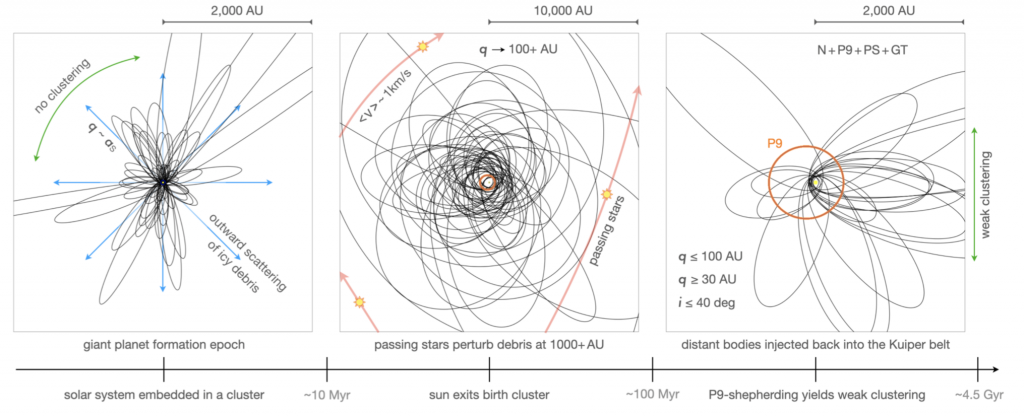
Мы рады, что вы снова выбрали нас для своего путешествия! Мы действительно взволнованы увидеть, что на самом деле находится далеко, в Солнечной системе. Спасибо, что выбрали Astrobites Airlines!
https://astrobites.org/2021/04/29/astrobites-airlines-were-going-to-planet-9/
2021-04-29 13:03:16Z
CBMiTWh0dHBzOi8vYXN0cm9iaXRlcy5vcmcvMjAyMS8wNC8yOS9hc3Ryb2JpdGVzLWFpcmxpbmVzLXdlcmUtZ29pbmctdG8tcGxhbmV0LTkv0gEA
Bagikan Berita Ini















0 Response to "Astrobites Airlines: We're going to Planet 9! - Astrobites"
Post a Comment